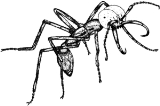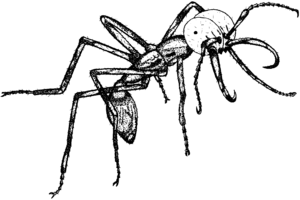
Eciton burchellii
Encyclopedia
Eciton burchellii is the predominant species
of the genus
Eciton
and a type of New World
army ant
. Distinct in its expansive, highly organized swarm raids, it is often considered the archetypal species of "army ant" — so much that the term has become its common name
— and remains one of the most heavily investigated of all ant species.
 Like most ant species, they are polymorphic
Like most ant species, they are polymorphic
, meaning that individuals vary in size: a colony
contains workers ranging from 3 mm to 12 mm, with each specific "caste" suited to specialized tasks. Like other species of Eciton
, E. burchellii features a highly modified soldier caste bearing long, pointed, characteristically falcate (sickle
-shaped) mandibles. Their long legs
and elongated body lend them a spider-like appearance. Color varies from deep golden to dark brown. Workers possess single-faceted compound eyes, double-segmented waists, a well-developed sting, and specialized tarsal hooks on their feet with which they cling to one another to form bridges and bivouacs.
Colonies may be quite large, accommodating as many as 100,000 to 2,000,000 adult individuals. Each colony consists of a single queen, a brood of developing young, and a majority of adult workers.
Members of the species have been observed using their bodies to block potholes in a path between the nest and prey. The ants will each walk to a hole and measure themselves to see if they are a fit for it and if they are, will lie across the hole to allow other members of the colony to cross at higher speed. If they do not fit, they will continue past the hole and allow another ant to check. Once in place in a hole the ant can stay there for many hours, until it is dark and the traffic flow has diminished greatly, at which point they will return to the nest.
 The species was referred to as Eciton burchellii in the original publication. The double i was subsequently deemed unnecessary in the later 1800s by taxonomists, and hence the name became Eciton burchelli. Recent taxonomic rules, however, adhere more strictly to the original form; the name Eciton burchelli is now largely regarded as invalid.
The species was referred to as Eciton burchellii in the original publication. The double i was subsequently deemed unnecessary in the later 1800s by taxonomists, and hence the name became Eciton burchelli. Recent taxonomic rules, however, adhere more strictly to the original form; the name Eciton burchelli is now largely regarded as invalid.
s and woodcreeper
s. Insects and other arthropods attempting to escape from E. burchellii are flushed into the attending flocks, and a number of species have evolved behavior to obtain most of their food by following swarms. Butterflies are then attracted to the droppings of the birds following the ants, which they drink from. Stylogaster
and Calodexia
flies are abundant around raiding parties, laying eggs (or injecting larvae) on fleeing cockroaches; of the cockroaches that escape the ants, 50-90% are parasitised by the flies. Many mites live in the bivouacs and ant columns, on Barro Colorado Island
, Panama, 4% of the worker ants had mites on them with the Scutacaridae and Pygmephoridae families being the most abundant. Beetles which mimic the ants can be found in the bivouac and in columns. The mites are mainly thought to be harmless to the ants, being symbionts rather than parasites.
Anatomy
Species
In biology, a species is one of the basic units of biological classification and a taxonomic rank. A species is often defined as a group of organisms capable of interbreeding and producing fertile offspring. While in many cases this definition is adequate, more precise or differing measures are...
of the genus
Genus
In biology, a genus is a low-level taxonomic rank used in the biological classification of living and fossil organisms, which is an example of definition by genus and differentia...
Eciton
Eciton
The New World army ant genus Eciton contains the most familiar species of army ants. The most predominant and well-known species is Eciton burchellii, whose common name is "army ant" and which is considered to be the archetypal species....
and a type of New World
New World
The New World is one of the names used for the Western Hemisphere, specifically America and sometimes Oceania . The term originated in the late 15th century, when America had been recently discovered by European explorers, expanding the geographical horizon of the people of the European middle...
army ant
Army ant
The name army ant is applied to over 200 ant species, in different lineages, due to their aggressive predatory foraging groups, known as "raids", in which huge numbers of ants forage simultaneously over a certain area, attacking prey en masse.Another shared feature is that, unlike most ant...
. Distinct in its expansive, highly organized swarm raids, it is often considered the archetypal species of "army ant" — so much that the term has become its common name
Common name
A common name of a taxon or organism is a name in general use within a community; it is often contrasted with the scientific name for the same organism...
— and remains one of the most heavily investigated of all ant species.

Polymorphism (biology)
Polymorphism in biology occurs when two or more clearly different phenotypes exist in the same population of a species — in other words, the occurrence of more than one form or morph...
, meaning that individuals vary in size: a colony
Ant colony
An ant colony is an underground lair where ants live, eat and mate. Colonies consist of a series of underground chambers, connected to each other and the surface of the earth by small tunnels. There are rooms for nurseries, food storage, and mating...
contains workers ranging from 3 mm to 12 mm, with each specific "caste" suited to specialized tasks. Like other species of Eciton
Eciton
The New World army ant genus Eciton contains the most familiar species of army ants. The most predominant and well-known species is Eciton burchellii, whose common name is "army ant" and which is considered to be the archetypal species....
, E. burchellii features a highly modified soldier caste bearing long, pointed, characteristically falcate (sickle
Sickle
A sickle is a hand-held agricultural tool with a variously curved blade typically used for harvesting grain crops or cutting succulent forage chiefly for feeding livestock . Sickles have also been used as weapons, either in their original form or in various derivations.The diversity of sickles that...
-shaped) mandibles. Their long legs
Arthropod leg
The arthropod leg is a form of jointed appendage of arthropods, usually used for walking. Many of the terms used for arthropod leg segments are of Latin origin, and may be confused with terms for bones: coxa , trochanter , femur, tibia, tarsus, ischium, metatarsus, carpus, dactylus ,...
and elongated body lend them a spider-like appearance. Color varies from deep golden to dark brown. Workers possess single-faceted compound eyes, double-segmented waists, a well-developed sting, and specialized tarsal hooks on their feet with which they cling to one another to form bridges and bivouacs.
Colonies may be quite large, accommodating as many as 100,000 to 2,000,000 adult individuals. Each colony consists of a single queen, a brood of developing young, and a majority of adult workers.
Members of the species have been observed using their bodies to block potholes in a path between the nest and prey. The ants will each walk to a hole and measure themselves to see if they are a fit for it and if they are, will lie across the hole to allow other members of the colony to cross at higher speed. If they do not fit, they will continue past the hole and allow another ant to check. Once in place in a hole the ant can stay there for many hours, until it is dark and the traffic flow has diminished greatly, at which point they will return to the nest.
Taxonomy

Associated species
A total of 557 different species of animal have been found to associate in some way with E. burchellii, the greatest number known for any individual species. An even larger number of species have been recorded living with the ants, but have not yet been identified. Although some of the associations are likely to be opportunistic, around 300 of the species are thought to be reliant on E. burchellii in some form to survive. The species is commonly attended by "ant following" birds such as antbirdAntbird
The antbirds are a large family, Thamnophilidae, of passerine birds found across subtropical and tropical Central and South America, from Mexico to Argentina. There are more than 200 species, known variously as antshrikes, antwrens, antvireos, fire-eyes, bare-eyes and bushbirds...
s and woodcreeper
Woodcreeper
The woodcreepers comprise a subfamily of sub-oscine passerine birds endemic to the Neotropics. They have traditionally been considered a distinct family Dendrocolaptidae, but most authorities now place them as a subfamily of the ovenbirds...
s. Insects and other arthropods attempting to escape from E. burchellii are flushed into the attending flocks, and a number of species have evolved behavior to obtain most of their food by following swarms. Butterflies are then attracted to the droppings of the birds following the ants, which they drink from. Stylogaster
Stylogaster
The conopid genus Stylogaster is a group of unusual flies. It is the only genus in the subfamily Stylogastrinae, which some authorities have historically treated as a separate family Stylogastridae .-Biology:...
and Calodexia
Calodexia
Calodexia is a genus of flies in the family Tachinidae....
flies are abundant around raiding parties, laying eggs (or injecting larvae) on fleeing cockroaches; of the cockroaches that escape the ants, 50-90% are parasitised by the flies. Many mites live in the bivouacs and ant columns, on Barro Colorado Island
Barro Colorado Island
Barro Colorado Island is located in the man-made Gatun Lake in the middle of the Panama Canal. The island was formed when the waters of the Chagres River were dammed to form the lake. When the waters rose, they covered a significant part of the existing rainforest, and the hilltops remained as...
, Panama, 4% of the worker ants had mites on them with the Scutacaridae and Pygmephoridae families being the most abundant. Beetles which mimic the ants can be found in the bivouac and in columns. The mites are mainly thought to be harmless to the ants, being symbionts rather than parasites.
External links
- Army Ants: Inside the Ranks - National Geographic MagazineNational Geographic MagazineNational Geographic, formerly the National Geographic Magazine, is the official journal of the National Geographic Society. It published its first issue in 1888, just nine months after the Society itself was founded...
- BBC videos of Eciton burchellii
External images
In situ- http://www.armyants.org/armyants/genusfigures/eciton/misc/paraguaypics.html
- http://www.myrmecos.net/ants/eciton.html
Anatomy
- Worker castes
- Major worker: frontal view; lateral view
- Minor worker: frontal view; lateral view

